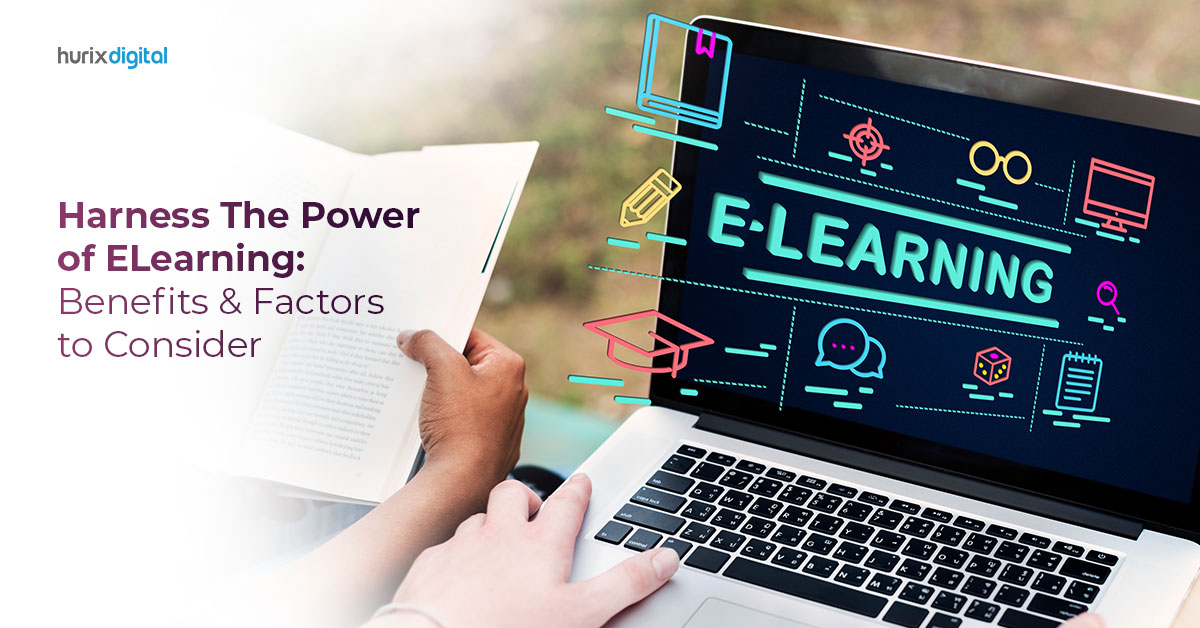
Harness The Power Of ELearning: Benefits & Factors To Consider
eLearning, also known as electronic learning, is a form of learning that involves the use of electronic devices and digital technologies to deliver educational content.
With the rise of technology, eLearning has become increasingly popular in recent years, and individuals, educational institutions, and corporations worldwide now use it. As a fact, by 2025, the global eLearning market is expected to be worth $325 Billion.
eLearning solutions offer many benefits, including convenience, flexibility, cost-effectiveness, and personalized learning, among others. In this article, we’ll take a closer look at eLearning along with its benefits and factors to consider when implementing an eLearning solution.
Table of Contents:
- Ten Different Types Of eLearning Solutions
- Five Benefits Of eLearning
- Factors To Consider When Implementing An eLearning Solution
- Trends In eLearning
- Best Practices For Implementing eLearning Solutions
- Conclusion
Ten Different Types Of eLearning Solutions
Various types of eLearning solutions are available, each with its unique features and benefits.
Here are some different types of eLearning solutions
- Asynchronous eLearning:- Self-paced learning where learners can access materials anytime, anywhere.
- Synchronous eLearning:- Live, instructor-led training delivered online in real-time.
- Mobile Learning (mLearning):- eLearning is designed specifically for mobile devices, such as smartphones and tablets.
- Microlearning:- Short, focused eLearning modules that can be completed in a few minutes.
- Virtual Classroom:- An online environment where learners can interact with instructors and classmates in real time.
- Webinars:- Live online seminars that can be attended from anywhere worldwide.
- Game-based Learning:- Gaming-based learning is eLearning that uses gaming aspects to make the subject matter more interesting and fun.
- Simulation-based Learning:- Simulation-based learning is online instruction that mimics real-world situations to let learners exercise their abilities and make decisions.
- Adaptive Learning:- Adaptive learning is online education that customizes the learning process based on the requirements and abilities of the student.
- Social Learning:- Social learning is eLearning that encourages participants to work together and share knowledge through online forums and communities.
Five Benefits Of eLearning
1. Convenience And Flexibility
One of the primary advantages of eLearning is the ease and flexibility it offers. Learners can access content through eLearning from any location, at any time, and on any device. This means that students may learn at their speed and on their schedule, which is very useful for individuals who have hectic schedules or reside in remote places.
2. Cost-Effective
eLearning is frequently a less expensive option than conventional classroom training. There are no charges related to travel, lodging, or venue rental with eLearning. Furthermore, because all knowledge is given online, the cost of resources such as textbooks and workbooks is also minimized.
3. Increased Access To Expertise
eLearning solutions can be used to provide access to subject matter experts who may not be available locally. This means that learners can benefit from the expertise of professionals from all over the world.
4. Improved Retention And Engagement
It is possible to create dynamic and engaging eLearning solutions that can increase learner retention. Videos, animations, and games are just a few examples of multimedia components that may be used in eLearning to keep students interested and motivated.
5. Personalized Learning
eLearning solutions can be designed to cater to the individual needs and learning styles of each learner. Learners can progress through content at their own pace, and content can be delivered in a variety of formats to suit different learning preferences.
Factors To Consider When Implementing An eLearning Solution
- Content:- The success of an eLearning solution depends on the caliber and relevancy of the content. The content should be well-organized, interesting, and pertinent to the needs and interests of the learners.
- Instructional Design:- Instructional design is the process of creating effective eLearning content. Instructional design should take into account the needs and preferences of the learners, as well as the objectives of the training.
- Technical needs:- When establishing an eLearning system, technical needs such as internet access, bandwidth, and hardware should be taken into account. It is crucial to guarantee that students have wangle to the technology they need to take part in the eLearning program.
- LMS, or learning management system:- The software platform that provides students with eLearning content is tabbed a learning management system (LMS). It’s crucial to take into worth aspects like usability, scalability, and system integration while selecting an LMS.
- Support and Training:- Support and training are essential for an eLearning solution’s success. Learners should have access to technical assistance and assistance from instructors or mentors as needed. Additionally, teachers and administrators should be trained on how to use the eLearning platform and successfully support learners.
Trends In eLearning
Several trends are influencing the future of the eLearning industry, which is an ever-changing field. Virtual reality (VR) and artificial intelligence (AI) are two of the most crucial eLearning developments.
VR is also becoming increasingly popular in eLearning, allowing students to immerse themselves in virtual surroundings that mimic real-world circumstances. This technology is especially effective for training in high-risk sectors like healthcare or manufacturing, where errors may be costly or hazardous.
VR has the potential to open up new avenues for collaborative learning and distant education by allowing students to connect with instructors and classmates in virtual environments.
Other eLearning trends include using gamification components to make learning more engaging and fun and the usage of microlearning, which offers brief, targeted material in bite-sized portions. As technology advances, it is expected that eLearning will develop and adapt to new trends and breakthroughs.
Best Practices For Implementing eLearning Solutions
The process of implementing eLearning solutions can be difficult, but several best practices can assist in making the process effective.
The eLearning program’s aims and objectives must first be clearly stated. This will aid in determining the program’s scope, target audience, and resource requirements.
Next, it’s essential to choose the right eLearning solution that meets the organization’s needs, taking into account factors such as the type of content to be delivered, the level of interactivity required, and the technical requirements.
Once the eLearning solution is chosen, creating high-quality content that is engaging, interactive, and relevant to the learner’s needs is vital. A constructive learning management system (LMS) should be chosen to track progress and provide feedback to learners.
It’s also important to provide ongoing support and training to ensure learners and instructors are comfortable with the eLearning platform and have access to technical support if needed.
Conclusion
eLearning solutions offer many benefits, including convenience, cost-effectiveness, improved retention and engagement, personalized learning, and increased access to expertise.
However, when implementing an eLearning solution, it is important to consider factors such as content, the Learning Management System (LMS), instructional design, technical requirements, and support and training.
By considering these factors and designing an effective eLearning solution, organizations can provide learners with a flexible, engaging, and effective way to learn.
Contact Hurix to explore more ways to incorporate the best practices of eLearning and make your training system future-ready.
Also Read – Online Assessment: The Future Of E-Learning

Performance, Results, Growth, and Life-Long Learning define my professional life. I am passionate about making workplace learning planful, purposeful, and impactful. I take pride in partnering with clients and bringing them the best in learning design and creating solutions that address business challenges.





